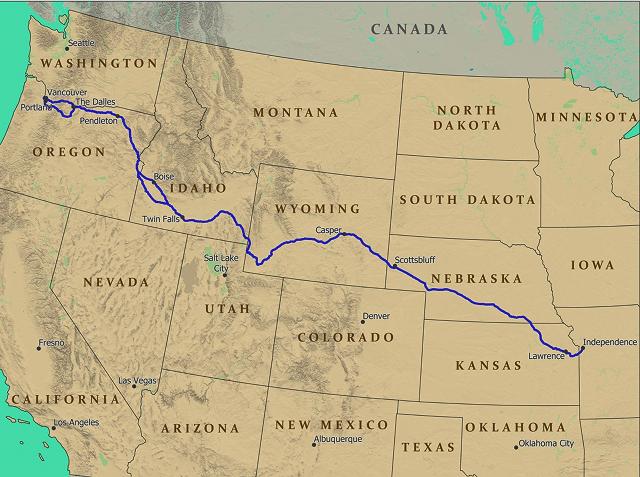 |
Canku Ota
|
 |
|
(Many Paths)
|
||
|
An Online Newsletter
Celebrating Native America
|
||
|
May 2021 - Volume 19
Number 5
|
||
|
|
||
|
New 'Oregon Trail'
Game Revisits Westward Expansion From Native Perspective
|
||
|
by Livia Gershon - SMITHSONIANMAG.COM
|
||
|
Developers hired
three Indigenous historians to help revamp the iconic educational
computer game
The iconic video game "The Oregon Trail" is back with a new version—and a more nuanced approach to the story of white settlers traveling across the American West in 1848.
As Kimber Collins reports for WKRG, the updated iteration, created by Gameloft, is now available through the Apple Arcade subscription service. First launched in 1971 as a computer game, "The Oregon Trail" lets users step into the role of wagon leader. Players struggle to keep people and oxen alive in the face of starvation, dysentery and other dangers. The new game opens with a message from developers acknowledging that earlier versions of "The Oregon Trail" failed to depict Native American perspectives and cultures. "For Indigenous Peoples, westward expansion was not an adventure but an invasion," they write. The game now features playable Native American characters. Developers hired three Native American historians to help design the virtual figures' appearance, speech and roles. "Initially, all of the Native people [in the revamped game] had braids," Margaret Huettl, a historian at the University of Nebraska who helped advise the team, tells Anna King of NW News Network. "And I think we suggested, maybe they don't all have to have braids." Game designers also removed stereotypical flute and drum music. While the team had originally seen bows and arrows as a fun game mechanic, developers soon learned that these weapons weren't realistic for the historical moment depicted. Huettl says Native American trappers at the time the game is set were more likely to have carried rifles, making bows an outdated stereotype. "That wasn't our intention at all, obviously," Gameloft Brisbane's creative director, Jarrad Trudgen, tells NW News. "We were just coming to it sort of as a naive 'bows and arrows are cool' angle." As Jazz Halfmoon says to NW News, she played "The Oregon Trail" at her school on the Confederated Tribes of the Umatilla Indian Reservation, in northeast Oregon, years ago. (The game was frequently incorporated in history lessons in American schools between the 1970s and 1990s.) Despite the limited graphics, students were excited to receive time playing on the computer as a reward for good work. But Halfmoon, who's now 38, says she viewed the game differently than users playing outside of the reservation might have. "I remember being like, 'Oh, like the Indians killed off somebody in your wagon train' ... and then being like, 'Oh, we're Indians, you know,'" she explains. In the new version, writes University of San Diego historian T.J. Tallie for Hyperallergic, "Indigenous North Americans are no longer background characters in what was, upon reflection, a wildly solipsistic game. In historically accurate clothing, fully playable and realized Indigenous characters respond to settlers as equals, have full dialogue, and even their own game play scenarios."
The updated iteration of "The Oregon Trail" is not the first video game to address Native Americans' experiences with westward expansion. The 2019 game "When Rivers Were Trails" depicts the adventures of an Anishinaabeg person who is displaced from the tribe's land in Minnesota in the 1890s and travels west to California. Players can hunt, fish, canoe and meet people from different Native American nations. As Jennifer Billock wrote for Smithsonian magazine in 2016, the real Oregon Trail brought more than 400,000 people out west between 1840 and 1880. The trail ran for 2,170 miles, from Independence, Missouri, to the Willamette Valley in Oregon. Today, visitors can still see ruts from wagon wheels in a number of spots across the country. The United States government encouraged white settlement in Oregon to strengthen the country's claim on the land, wrote Eric Cain and John Rosman for Oregon Public Broadcasting in 2017. Without permission from any of the 60-plus tribes that lived there, Congress passed the Oregon Donation Land Act, which offered 320-acre parcels to migrants, in 1850. Settlers claimed 2.8 million acres over the next five years. White miners, ranchers and other settlers killed hundreds of Native American people, and many more died of diseases brought by the newcomers. "That settlement of Oregon then was initially just a theft of land," Oregon State University anthropologist David Lewis, who is a member of the Confederated Tribes of Grand Ronde, tells NW News. "By and large, the experience of Native people was one of continual loss for the first 70 or 80 years."
White
Earth Nation Confederated
Tribes of the Umatilla Indian Reservation |
|||||||
|
|
|
||
|
|
||
| Canku Ota is a free Newsletter celebrating Native America, its traditions and accomplishments . We do not provide subscriber or visitor names to anyone. Some articles presented in Canku Ota may contain copyright material. We have received appropriate permissions for republishing any articles. Material appearing here is distributed without profit or monetary gain to those who have expressed an interest. This is in accordance with Title 17 U.S.C. Section 107. | ||
|
Canku Ota is a copyright ©
2000 - 2021 of Vicki Williams Barry and Paul Barry.
|
||
 |
 |
|
|
The "Canku
Ota - A Newsletter Celebrating Native America" web site and
its design is the
|
||
|
Copyright ©
1999 - 2021 of Paul C. Barry.
|
||
|
All Rights Reserved.
|
||


